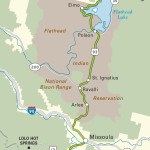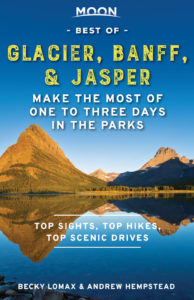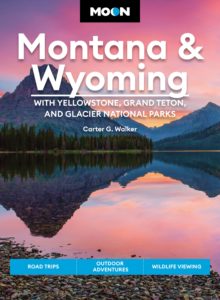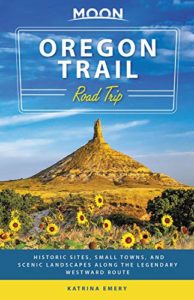Eureka to Whitefish
Eureka
Like British Columbia, Montana’s northwest corner, where BC Hwy-93 ends and US-93 begins, is an isolated land of dense forests, broad rivers, and glaciated valleys. Besides providing natural habitat for herds of moose, elk, bison, and bighorn sheep, not to mention mountain lions, wolves, and grizzly bears, the thick groves of cedars, pines, and firs support the Northwest’s other endangered species—the logger—whose angular clear-cuts and monocrop tree plantations are also apparent as you pass through the region.
The first sizable town, 13 mi (22 km) south of the border, is Eureka (pop. 1,118), a sleepy little place with a pair of gas stations, a couple of cafés, and Tobacco Valley Historical Village (406/297-7654, summer only), a fascinating collection of pioneer buildings, preserved and moved to a small park along US-93 at the south end of town.
For a truly unusual experience, spend the night in the former U.S. Forest Service fire lookout (around $35) atop Webb Mountain, about 24 mi (39 km) southwest of Eureka. It’s popular; for details and rental availability, contact Recreation.gov (877/444-6777).
Whitefish
A major division point on the historic Great Northern Railway, whose tracks are still in use by Amtrak and the Burlington Northern Santa Fe, Whitefish (pop. 7,870) was originally known as Stumptown because of the intensive logging operations centered here. Despite its proud industrial history, the blue-collar base has long since been eclipsed by tourism, and the city now calls itself the “Recreational Capital of Montana,” with alpine lakes, fishing streams, hiking trails, great skiing, and endless mountain scenery right on its doorstep. The main attraction in Whitefish, for skiing in winter and hiking and mountain biking in summer, is “The Fish,” a.k.a. Whitefish Mountain Resort, which surrounds the 6,817-fot (2,077 m) peak (with a 2,353-ft/717-m vertical drop!) that looms over the northwest shore of Whitefish Lake.
Besides giving access to the surrounding great outdoors, Whitefish is a pleasant place to stop and stretch your legs, and it has everything you could want from a resort town—without the rampant tourist-pandering and real estate speculation that has ruined so many other places. A small museum (Mon.-Sat., free) inside the rustic Great Northern train station, which stands in a pleasant park at the north end of Depot Park, gives a historical overview of Whitefish. Across the park from the station there’s a theater and a library, and the Great Northern Brewing Company, which has hoppy products that you can sample in a small tasting room (2 Central Ave.) or in any Whitefish bar.
The heart of town is a few blocks of Central Avenue, running south from the railroad tracks to one of Montana’s three Frank Lloyd Wright buildings, an early 1950s bank and office complex on the east side of Central Avenue between 3rd and 4th Streets called, directly enough, the Frank Lloyd Wright Building. In between you’ll find some great bars and saloons, art galleries, and Bookworks of Whitefish (3rd St. and Spokane St.).
The best place to start the day in Whitefish is along 3rd Street, east of Central Avenue, where the Buffalo Café (514 E. 3rd St., 406/862-2833) is a popular breakfast and lunch spot, locally famous for its huevos rancheros. Other places line up along Central Avenue, so you can get great burgers or wood-fired pizza or simply quaff a beer or two—all in the same block.
For a place to stay and get to know Whitefish, you can choose from numerous motels along US-93 south of town. The nicest in-town lodging option is walkably close to downtown: the attractive and comfortable Garden Wall Inn (504 Spokane Ave., 406/862-3440 or 888/530-1700, $155 and up), a Craftsman cottage.
Related Travel Guides
Travel Map of the Border to Border Route through Montana

















